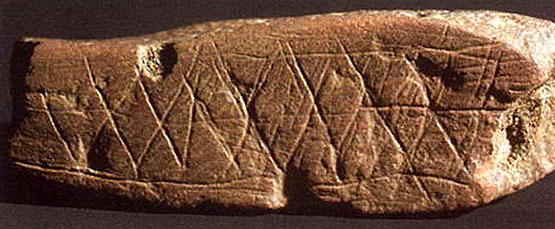(Students at the Cape Field School Programme learn about archaeology by performing excavations at Bombos Cave, South Africa)
All of these objects--the toolkits and stone implements both--were associated with the preparation of ochre, colored earth or rock that could be ground down to produce a colorful powder. Although it is known that this powder was used as a pigment (and, in fact, is still used in many cultures today), it is not clear in exactly what way. Early humans may have used it to decorate bodies and clothing; it was later applied to cave walls to create some of the beautiful artwork that can still be found today.
The toolkits, which were positioned 16 cm apart, consisted of abalone (Haliotis midae) shells filled with smaller ochre-manipulating objects. These included pieces of bone (some burnt), charcoal fragments, flakes and chips of ochre, and quartz and quartzite fragments of various sizes. Many of the objects were covered with prepared ochre; one cobble, lodged within the opening of the first toolkit, had a layer of ochre 5 mm thick, suggesting that the prepared final product dried in place before it could be used.
(Examples of ochre)
The authors have no way of knowing how the ochre was manufactured, but they used logic to guess at the procedure. They suggest that the first step was to rub a piece of ochre on the quartzite slabs in order to produce a red powder; additionally, some of the ochre might have been knapped (or fractured via repeated strikes with another rock). The chips produced by knapping might have been crushed, with the quartz and quartzite used as hammers and grinders. Similar methods were likely used to grind other minerals, producing different shades of powder. Bone might have been added for its marrow, which acts as a binding compound; it likely was heated first so that the marrow was easier to extract. Finally, the products of these efforts might have been added to other collected ingredients and stirred in the abalone shells.
(Another, earlier finding from Blombos Cave. This piece of crosshatched ochre represents some of--if not the--earliest abstract art produced by Homo sapiens.)
In addition to the lack of concrete information on how the toolkits might have been employed to prepare ochre, there is also no indication of how that ochre was used or applied--though one of the bones may have been used as sort of a scoop or paintbrush, transferring the compound from the shell to its ultimate destination. Some of the toolkit's contents bore multiple layers of color, indicating that they had been reused during successive rounds of ochre preparation. This, the close proximity of the 2 toolkits, and the lack of any other artifacts in the cave, cumulatively suggest that Blombos Cave was used as a workshop. It is hard to guess at how long it may have played this role, but the toolkits appear to have been left shortly after the last round of compounds was completed; sands then blew into the cave from outside and "encapsulated" the toolkits until their recent recovery.
The 2 shells were likely collected from the intertidal zone that, in the time of the ochre preparers, was only a few hundred meters from the cave. Some of the minerals were brought from other locations at least several kilometers away. All the other toolkit components appear to have been sourced from the environment near the cave. The selection and gathering of these objects, the creation of the ochre compound, and the use of containers all indicate that early humans living near Blombos Cave were capable of long-term planning and had some "elementary knowledge of chemistry." In addition to providing a tantalizing glimpse of the lives of our distant ancestors, these technological and behavioral attributes offer further support for recent genomic and phenomic diversity studies that indicate that Homo sapiens originated in South Africa.
---
For supplementary images associated with this post, please visit the Anthrophysis pin board at Pinterest.
Henshilwood, C.S., d'Errico, F., van Niekerk, K.L., Coquino, Y., Jacobs, Z., Lauritzen, S.-E., Menu, M., García-Moreno, R. 2011. A 100,000-year-old ochre-processing workshop at Blombos Cave, South Africa. Science 334:219-222.
Thanks to the following websites for providing the images used in this post:
http://www.asu.edu/clas/shesc/projects/cape/CFS_Program.htm
http://www.sinopia.com/yellow-ochre-pigments.aspx
http://jeremylent.wordpress.com/2010/10/31/out-of-africa/



No comments:
Post a Comment